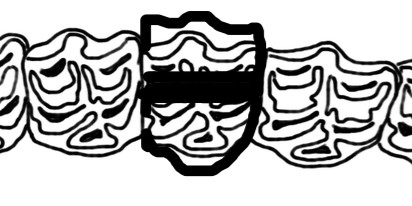A number of different configurations of dental fractures exist.

Figure 6. Lateral Sagittal Fracture
Parasagittal fractures through pulps no1 and no2 can be present in both maxillary and mandibular cheek teeth. The missing portions of these teeth are commonly shaded out (Fig 6).

Midline sagittal fractures through the infundibula of the maxillary teeth are drawn similarly if a portion is missing. If both portions are present they are drawn as displacements with a black line in between over the infundibula (Fig 7).
Figure 7. Midline Sagittal Fracture with displacement
Occlusal fissure fractures are not commonly drawn on the diagram but are mentioned in the narrative.
A number of different configurations of dental fractures exist.